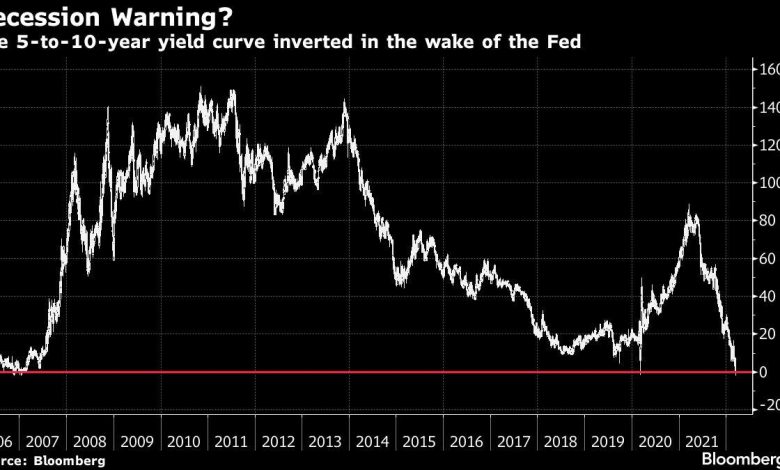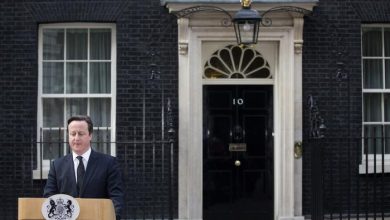Bond Traders Stunned by Hawkish Fed Are Sounding Growth Alarm

(Bloomberg) — Defying their stock-market counterparts, Treasury traders aren’t buying Jerome Powell’s upbeat pronouncements about the economy. In fact, one bond-market indicator has started flashing red for the first time since the darkest days of the pandemic.
Most Read from Bloomberg
After the Federal Reserve raised interest rates on Wednesday and signaled hikes at all six remaining meetings this year, a part of the Treasury curve — the gap between five- and 10-year yields — inverted for the first time since March 2020. Meanwhile the difference between two- and 10-year yields continued to narrow.
These are time-honored indicators of oncoming growth pains as the inflation-fueling fallout from Russia’s invasion of the Ukraine continues. With officials projecting raising interest rates as high as 2.8% by the end of 2023, bond traders are growing increasingly concerned that the economy could buckle under the weight of monetary-policy normalization.
“The market is pricing in a higher recession risk and you can see that with the inversion between five- and 10-year yields,” said Andrzej Skiba, head of U.S. fixed income at RBC Global Asset Management. “The Fed is sending a strong commitment to fighting inflation.”
Overnight, the gap between three- and 10-year yields briefly inverted for the first time since 2007 as longer-dated Treasuries found buyers. The five- to 10-year curve reached minus 1.6 basis points, while the difference between two- and 10-year yields shrank to 18.5 basis points, last seen in March 2020. All three curve spreads subsequently rebounded from those levels as the 10-year yield pared its decline. The flattening trend is fueled by expectations of a hawkish Fed pushing up policy-sensitive front-end yields, while longer-maturity yields are held down by concern that higher policy rates will lead to a recession.
The eurodollar futures curve, a proxy for the direction of the Fed’s policy rate over the next several years, peaks at about 2.70%, the rate for the September 2023 contract. Longer-dated contracts trade at lower rates, suggesting that the Fed is viewed as likely to lower interest rates in that time frame.
In a meeting seen as hawkish on many fronts, Fed Chair Powell reiterated the central bank is keeping all options on the table to fight the hottest pace of inflation in decades. In turn, traders pushed the two-year yield to a new cycle high just shy of 2% and at one point priced in a more than three-in-four chance of a 50 basis point hike in May.
The upshot is that the big swings that have marked fixed-income trading this year have scope to continue.
While stock traders took solace in the Fed’s iron-clad resolve to restore price stability, bond investors — already grappling with worst performance for the Bloomberg Treasury index in decades — are bracing for fresh losses.
“It is as if Powell wants to sound upbeat but at the same time tough on inflation without signaling that this will ultimately end with a policy error and a risk of a recession on the back-end,” said George Goncalves, head of U.S. macro strategy at MUFG. “Time will tell.”
Warnings Abound in Market Circles as Fed Error Bets Seen Rising
The Fed’s forecasts for aggressive hikes were deemed by some as an admission that policy has fallen behind the curve given elevated inflation. At the same time, in the press conference that followed the interest-rate decision, Powell’s hawkish signals also posed a challenge to those in the bond market that had expected a more measured tightening pace, given the uncertain global economic backdrop.
Powell downplayed the risk of a U.S. recession next year, saying the Fed aims to tighten monetary policy without sacrificing economic growth.
Treasuries were off session highs in U.S. trading Thursday after a round of robust economic data, having rebounded from Wednesday’s steep selloff during Asia and Europe trading hours. U.S. equities were little changed after rebounding sharply over the past two days.
“They are in full mode of trying to bring inflation down,” Diane Swonk, chief economist at Grant Thornton, said on Bloomberg Television. She predicted the U.S. economy will slow during the second half and is at risk of a recession given the twin blow of Fed tightening and higher oil prices.
Whether a Fed-spurred tightening in financial conditions would materially undercut economic growth and hurt stocks anew is an open question. So is the likelihood of a pause hikes by the middle of the year — when the central bank is also expected to be in the process of shrinking its near $9 trillion balance sheet — if the volatile global backdrop endures.
Until clarity emerges on these fronts and more, big swings in the bond market will remain the order of the day.
“Market volatility is always higher when you don’t have the answers,” said RBC’s Skiba.
(Adds eurodollar curve in sixth paragraph, updates yield changes.)
Most Read from Bloomberg Businessweek
©2022 Bloomberg L.P.
Source link





